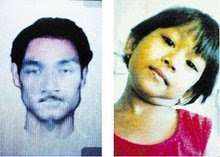Berita Harian - 17 Januari 2008| Khamis
Oleh Jami’ah Shukri
Setiap tahun banyak kejadian jenayah dalam banyak kategori dilaporkan. Keruntuhan sosial dan moral masyarakat memburukkan lagi keadaan, selain kemasukan pendatang asing serta pengaruh suasana sekeliling turut menjadi penyumbang.
Kes jenayah di negara ini juga dilaporkan meningkat dan memerlukan pemantauan dan penguatkuasaan serius bagi mengurangkannya. Indeks jenayah dilaporkan meningkat sebanyak 14,910 atau 7.12 peratus kepada 224,298, tahun lalu berbanding 209,388 pada 2006.
Lima lagi kategori jenayah yang menjadikannya kini 19 kategori, iaitu termasuk ugutan jenayah, menjatuhkan maruah, pemerasan, menyebabkan kecederaan dan merusuh dalam kumpulan lebih lima orang melonjakkan keseluruhan indeks itu.
Jenayah terhadap kanak-kanak seperti diculik, dibunuh serta dirogol, sejak kebelakangan ini terus dicatatkan. Sebagai langkah drastik kerajaan mewajibkan pemilik bangunan termasuk swasta serta premis tertentu memasang kamera litar tertutup (CCTV) sebagai langkah keselamatan dan alternatif untuk membantu siasatan mengesan jenayah.
Baru-baru ini, kerajaan juga meluluskan peruntukan khas RM75 juta untuk CCTV di beberapa kawasan strategik seluruh negara bagi mengatasi kejadian jenayah.
Sebagai permulaan 25 pihak berkuasa tempatan (PBT) memasang CCTV di kawasan yang paling terdedah dengan kegiatan jenayah dan akan diperluaskan di seluruh negara. Pada Dasarnya pemasangan CCTV adalah alternatif untuk memantau serta bertindak sebagai sumber maklumat penting mengesan kelibat penjenayah.
Ternyata, peruntukan yang besar bagi tujuan berkenaan selain menguatkuasakan pemasangan itu pada semua bangunan di nagara ini, menunjukkan kesungguhan pihak berkuasa. Dengan kesungguhan dan keprihatinan kerajaan itu, ia sepatutnya dipergunakan sebaiknya bagi memerangi jenayah.
Seperti luahan Perdana Menteri, Datuk Seri Abdullah Ahmad Badawi pemasangan CCTV bukan untuk menidakkan kuasa polis yang sudah hilang kawalan atau tidak berupaya untuk membanteras jenayah sebaliknya, situasi kadar jenayah yang semakin meningkat perlu difahami.
“Jika kita nak perangi jenayah, kita kena buat, pemilik kena pastikan bangunan mereka selamat supaya orang datang dan meletakkan kenderaan tanpa rasa bimbang,” katanya.
Penegasan terhadap pemasangan itu tidak seharusnya dipandang remeh. Ketika ini, sebilangan pemilik bangunan ada menyediakan CCTV, tetapi tidak berfungsi dengan baik dan apabila berlaku sesuatu kejadian jenayah, imej gagal dikesan.
Sebagai contoh, sebanyak 14 daripada 20 CCTV yang dipasang bagi tujuan mamantau keselamatan penduduk sekitar bandar raya di Melaka tidak berfungsi sehingga menimbulkan kebimbangan dan pelbagai persoalan apa yang sebenarnya tujuan pemasangan itu.
Apa sudah jadi? Kita percaya jika tidak kecoh seluruh negara mengenai isu kehilangan Sharlinie Mohd Nashar, 5, atau Ketua Menteri Melaka, Datuk Seri Mohd Ali Rustam membuat tinjauan di kawasan terbabit, kemungkinan keadaan CCTV itu tidak berfungsi.
Bagi kes Nurin Jazlin Jazimin, 8, yang menjadi mangsa penderaan seksual sebelum dibunuh, polis juga dilaporkan gagal memperoleh imej rakaman CCTV dengan jelas sehingga terpaksa ditingkatkan dengan menghantar ke makmal Biro Siasatan Persekutuan (FBI), Amerika Syarikat. Rakaman CCTV itu penting dalam membantu siasatan polis.
Lain pula dengan kes Ahli Dewan Undangan Negeri (Adun) Tenggaroh, Datuk S Krishnasamy yang ditembak di dalam lif bangunan MIC Johor, Johor Bharu ketika dalam perjalanan menghadiri mesyuarat perhubungan parti itu di tingkat dua, minggu lalu. Di situ, tidak dipasang CCTV sedangkan ia membabitkan premis orang kenamaan.
Hakikatnya, banyak lagi premis dan bangunan sedia ada yang dipasang CCTV tidak berfungsi. Jangan sudah terhantuk baru tengadah, sudah berlaku sesuatu kejadian jenayah baru terkial-kial mahu bertindak. Malaysia sudah bergerak ke arah negara maju, dan segala pengurusan berkaitannya hendaklah dilaksanakan dengan baik.
CCTV perlu berfungsi dengan baik dan diguna pakai sepanjang 24 jam, bukannya hanya aktif apabila sesuatu kes jenayah hangat diperkatakan dan kemudian ia menjadi hiasan. CCTV juga perlu diselenggara untuk memastikan ia berfungsi dengan baik. Pemilik bangunan seharusnya jujur dengan memasang alat yang berkualiti supaya tahan lama. Begitu juga dengan pembekal CCTV telus dengan mencadangkan produk berkualiti bukan untuk melariskan produk demi mengaut keuntungan.
Ada juga CCTV dipasang dan berfungsi seperti biasa iaitu mengikuti pergerakan imej yang melintasi premis tertentu, tetapi tidak merakamkan imej yang ada sekitarnya. Ini hanya bertujuan untuk menakutkan orang ramai, kononnya bangunan atau premis itu dilengkapi CCTV canggih. Natijahnya apabila berlaku sesuatu kes jenayah sukar mengesan apa yang sebenarnya terjadi.
Difahamkan pula ada syarikat yang menyediakan alat khas bagi mengesan sekiranya sesuatu premis atau bangunan itu memasang CCTV. Alat khas itu harus diharamkan penggunaannya kerana ia boleh disalah gunakan pihak tertentu terutama penjenayah untuk mengelak imej mereka dirakam.
Siasatan mungkin menjadi bertambah kompleks sekiranya polis tidak menemui bukti lain mengesan penjenayah.
Aktivis Keselamatan, K Balasupramaniam, berkata keputusan kerajaan memasang CCTV di kawasan strategik oleh PBT adalah idea yang baik untuk menjamin keselamatan dan membanteras kejadian jenayah.
Katanya, 90 peratus CCTV memberi kebaikan sama ada sebelum atau selepas kejadian jenayah berlaku.
“Dengan pemasangan CCTV akan dapat menakut-nakutkan orang ramai terutama yang ingin melakukan kegiatan menyalahi undang-undang berfikir dua kali terhadap risiko bakal ditanggung kerana aktiviti mereka akan dirakamkan.
“Risiko kedua pula, dengan ada CCTV semua aktiviti menyalahi undang-undang akan terakam dan ini dapat membantu pihak berkuasa untuk mengesan penjenayah dengan mudah,” katanya.
Bagaimanapun, beliau mencadangkan supaya pemilik bangunan mengadakan analisis risiko kawasan yang mudah terdedah kepada kejadian jenayah. Dengan analisis secara menyeluruh kawasan itu, matlamat pemasangannya lebih bermakna.
Misalnya, pemasangan CCTV di sekolah perlu diletakkan di pintu masuk bangunan serta kawasan yang mudah dibolosi penjenayah demi menjaga keselamatan pelajar.
Katanya, kerajaan juga perlu menetapkan satu piawaian serta prosedur operasi yang standard bagi semua CCTV, mencakupi aspek kualiti alat perakam, dikawal selia dengan baik serta mewajibkan setiap imej yang dirakam itu disimpan untuk tempuh tujuh hari.
“Jika hari ini sesuatu kejadian dirakamkan, kemudian esoknya dilupuskan, ia tidak dapat dijadikan bukti dalam siasatan polis. Biasanya apabila sesuatu kejadian jenayah seperti culik, rompakan, atau ragut berlaku, mangsa akan membuat laporan polis dalam tempoh 24 jam. Polis boleh melihat semula rakaman CCTV sebagai rujukan membantu siasatan,” katanya.
Sesungguhnya, pemasangan CCTV tidak bererti tugas mencegah kejadian jenayah diserahkan bulat-bulat pada pihak pemilik bangunan. Sudah pasti, semua anggota polis yang ada di seluruh negara tidak dapat dikerahkan bersengkang mata mengawasi setiap sudut kawasan dan bangunan.
Jika jumlah 60,000 anggota polis tambahan diambil dalam tempoh lima tahun hingga 2011 ini, ia juga tidak menjamin sifar jenayah dicatatkan di seluruh negara, tanpa kerjasama orang ramai.





